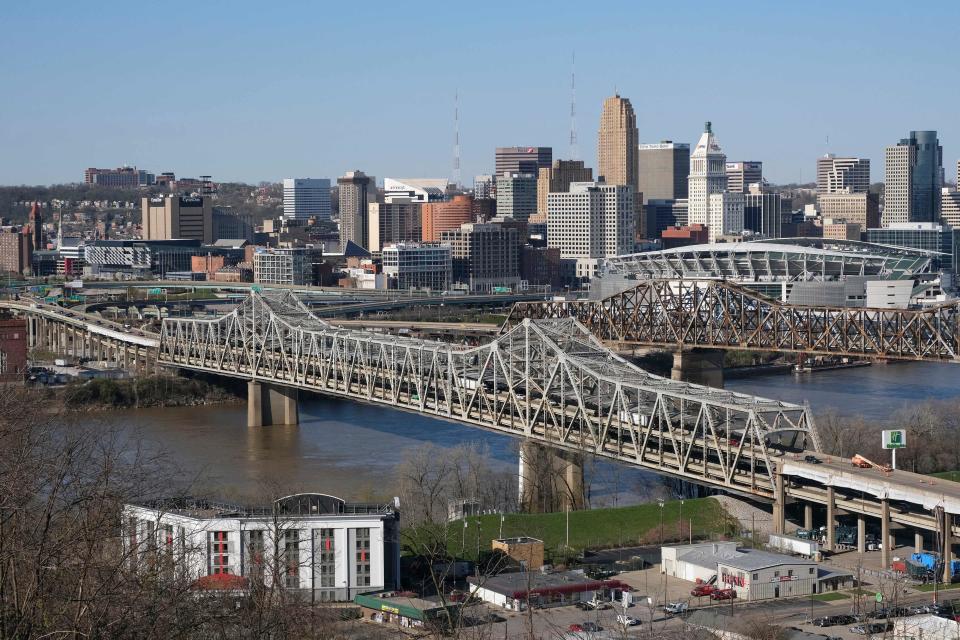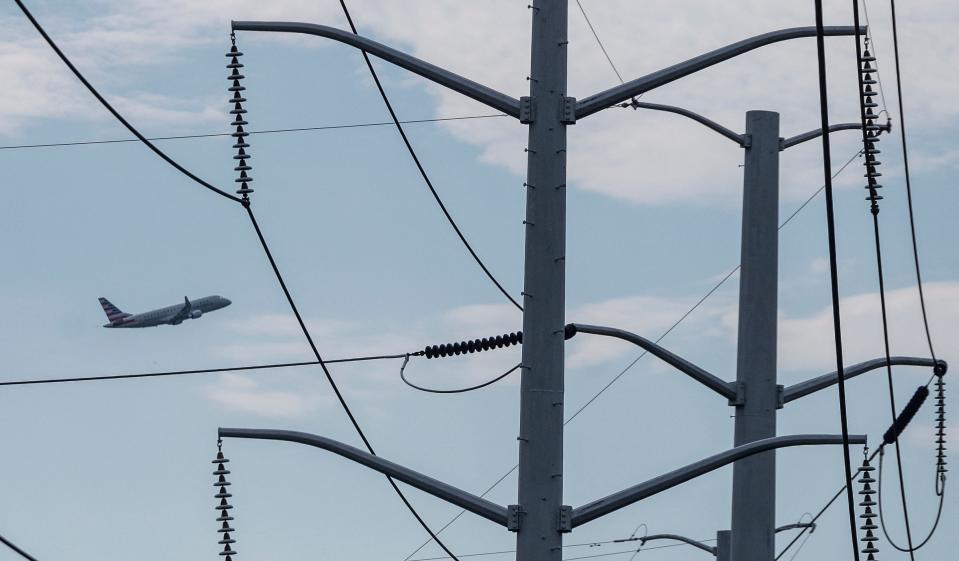Fairfield County Engineer: Too early to tell what infrastructure bill means for county
- Oops!Something went wrong.Please try again later.
LANCASTER — A new infrastructure bill could mean new avenues for funding projects throughout Fairfield County.
President Joe Biden signed a $1.2 trillion infrastructure bill on Monday that boosts funding for roads, bridges and public transportation across the country.
For Ohio, the law could mean a whole host of things: Money for Columbus transportation projects, a new bridge to ease congestion on the Brent Spence Bridge, broadband in Appalachia and maybe even Amtrak routes.
Federal and local officials say it's too soon to tell how the money could be spent in the Buckeye State in the coming years, but ground could start breaking on some projects as early as next year.
"These communities are ready for this," Sen. Sherrod Brown said.
Fairfield County engineer would spend funds on safety improvements
With nearly 400 bridges to maintain, Fairfield County Engineer Jeremiah Upp is curious to see how funds from the new infrastructure bill will be distributed, and how engineers throughout Ohio will be told where they can spend them.

He said while the intent of the funding may be to improve county bridges, he's considering three categories, should the funding be "open."
"I'd look at safety improvements throughout the county, paving roads and improving bridges, in that order. When we consider bridges within the county, there may be some that are considered functionally obsolete, but won't qualify for funding to be replaced," Upp said. "The bridges may be too narrow for farm equipment to cross safely, or the bridge may be on a road that's getting more traffic, but the structure of the bridge is still fine. Normally, those bridges wouldn't be looked at to be replaced, or earn funding for."
He explained the county conducts annual inspections of the county's bridges. The ratings from those inspections determines when a bridge is scheduled for repairs. The lower the score, the higher the priority.
"And given the choice, I'd prefer to use the infrastructure bill money towards safety improvements throughout the county, whether that's improved signing, helping make intersections safer or widening the road. One frustrating thing about getting money to help with safety improvements is you have to have a record of people getting hurt in order to get that money," Upp said. "So while we do get some heavier traffic around the northeast part of the county, we're still largely rural, so our traffic flow pales in comparison to more metro areas. Which makes it hard to compete for those safety improvement dollars."
"We have a tremendous need, but it's difficult to get."
Upp said he'd also consider using the money to help pave county roads. Asphalt costs have increased, and as a method to help the roads last longer, he said the county has chipped and sealed some roads. The intention is to return them to asphalt roads, but this will buy time until costs go back down, or the county can get money to pave roads.
Upp said the county maintains 347 bridges, with 230 of them meeting the federal guidelines to receive federal aid. He added some bridge structures have been replaced with box culverts when a study has deemed that method a better alternative, replacing a structure that lasts 30 years with one that will last around 100 years.
"We try to keep the big bridges programmed to receive federal funds. However, the process to get that money can mean it takes seven years to get the money to fix the bridge. For the shorter bridges, we utilize funding from the Ohio Public Works Commission, which takes about one year to approve the money," Upp said. "A lot of the money we receive through the OPWC is dedicated to bridge construction, because without a bridge, you can't have a road. That leaves us shorthanded for safety improvements."
Upp said while distribution of any federal funds provided by the infrastructure remains unclear, he'd be okay with them being distributed like OPWC funds.
Politics of new federal infrastructure bill
House lawmakers OK'd the infrastructure package on Nov. 5 after months of infighting among Democrats over how to proceed with that legislation and a social spending bill. Biden held a signing ceremony on Monday to tout a win for his administration as he fights low approval ratings.
The bill's passage is also a victory for retiring Sen. Rob Portman, who led negotiations with the White House and a bipartisan group of senators.
"It’s a model, and I hope it can be the beginning of a renewed effort to work together on big issues that face our country," Portman said.
While Portman and Brown both supported the bill, it failed to get bipartisan support among Ohio's House delegation. Rep. Anthony Gonzalez, who will not seek reelection next year, was the sole Republican to vote yes along with Democratic Reps. Tim Ryan, Joyce Beatty, Shontel Brown and Marcy Kaptur.

GOP lawmakers argued the package got caught up with the Democrats' reconciliation bill and went beyond addressing hard infrastructure.
"I've long favored a narrowly tailored infrastructure package to upgrade our nation’s roads, bridges and ports," U.S. Rep. Warren Davidson said. "However, I could not support this pork-laden bill, especially when Democrats have been so transparent that it is simply a means of delivering their next bad idea."
The legislation became a "partisan football" when it got to the House, Portman said, and tying it to the reconciliation bill made it difficult for many Republicans to support. Still, he argued most Ohio lawmakers know the infrastructure package will benefit their communities.
"Many of them understand that this bill will be good for their districts," he said. "They also believe the other bill will be very bad for their districts."
What's in the infrastructure bill for Ohio?
Politics aside, early estimates suggest Ohio will be able to dip into several pots of money for infrastructure needs.
The bill creates multiple funding mechanisms to help states repair and replace old, outdated bridges like the Brent Spence Bridge between Cincinnati and northern Kentucky. Included in that is $12.5 billion for the Bridge Investment Act, a measure authored by Brown that would provide grants of at least $50 million to bridges that cost over $100 million.
Officials say the $2.5 billion project to build a new bridge next to the Brent Spence will be a top candidate for federal grant money.
"It’s listed as one of the most notorious bridges in the country," Biden told WKRC last week. "And so my guess is that that’s going to be the choice that your governors are going to make and want to get done. And we can get it done now."
According to White House estimates, Ohio could receive $9.2 billion for federal-aid highway apportioned programs and $483 million to repair and replace bridges over a five-year period. The state can also compete for over $33 billion in grant funding for highway and multi-modal projects.

Ohio is also projected to get at least $100 million to improve broadband, $253 million for airports, $1.2 billion for public transportation and $1.4 billion dedicated to water infrastructure projects. The package includes $1.25 billion for the Appalachian Development Highway System — roughly $95 million of which would go to Ohio.
"It’s just way too early for specifics on the bill and what it means for Ohio," Ohio Department of Transportation spokesman Matt Bruning said. "However, I can say with confidence that we will work diligently to get every dime available to Ohio and invest those funds wisely to ensure our state has a safe and efficient transportation system."
The Central Ohio Transit Authority, meanwhile, already has some ideas up its sleeve. Patrick Harris, the assistant vice president of external affairs, said extra money could help cover more zero- and low-emission buses, as well as a transit corridor and new mobility center near Rickenbacker Airport.
Harris said COTA is grateful for the new investment but noted it will need additional support from lawmakers down the road as the Columbus region grows.
"While this is historic investment in public transportation," he said, "not one bill is going to be able to overcome the great need for public transit infrastructure across this country."
Haley BeMiller is a reporter for the USA TODAY Network Ohio Bureau, which serves the Columbus Dispatch, Cincinnati Enquirer, Akron Beacon Journal and 18 other affiliated news organizations across Ohio.
This article originally appeared on Lancaster Eagle-Gazette: County Engineer: Too early to see how infrastructure bill helps county

